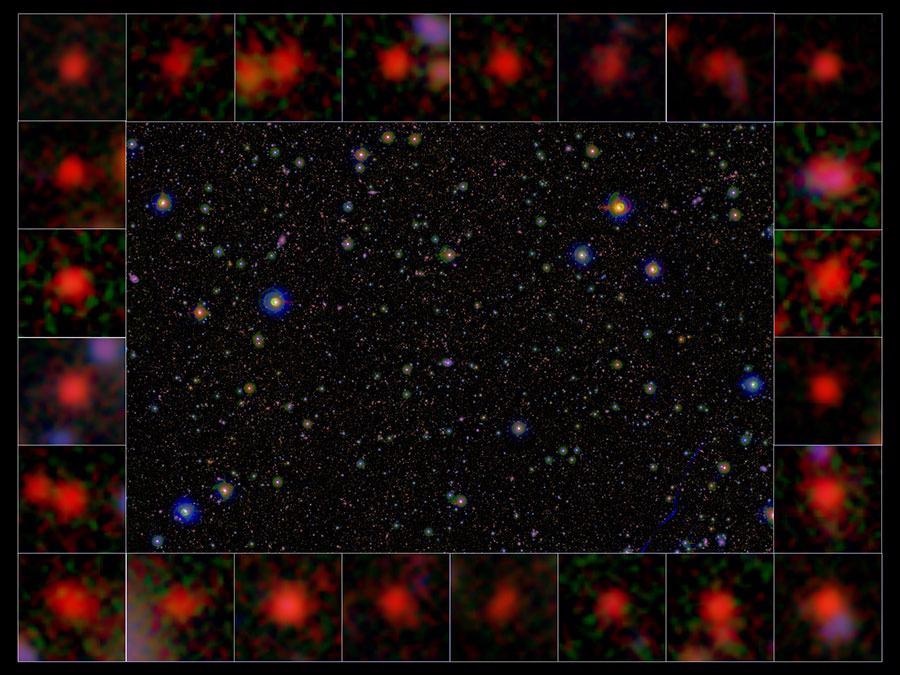To trace the signal from active supermassive black holes of dying galaxies in the early Universe, an international group of astronomers used a database incorporating observations from the world’s finest telescopes, including the Subaru Telescope.
 The COSMOS survey region surrounded by images of galaxies used in this study. In these galaxies star formation ceased around 10 billion years ago. (3-color false-color composite images combining data from the Subaru Telescope and VISTA). Image Credit: National Astronomical Observatory of Japan.
The COSMOS survey region surrounded by images of galaxies used in this study. In these galaxies star formation ceased around 10 billion years ago. (3-color false-color composite images combining data from the Subaru Telescope and VISTA). Image Credit: National Astronomical Observatory of Japan.
The occurrence of these active supermassive black holes is linked to changes in the host galaxy, implying that a black hole could have far-reaching consequences for its host galaxy’s evolution.
The Milky Way Galaxy contains stars of varying ages, as well as stars that are still forming. However, in some galaxies, identified as elliptical galaxies, all of the stars are old and similar in age. This suggests that elliptical galaxies had a timespan of prolific star formation early in their histories that abruptly ended.
It is unclear why star formation stopped in some galaxies but not in others. A supermassive black hole could disrupt the gas in some galaxies, generating an inappropriate environment for star formation.
Astronomers examine distant galaxies to test this theory. Light takes time to travel across the void of space because of its finite speed. The light that was observed came from an object 10 billion light-years away, and it took 10 billion years for it to reach Earth.
As a result, the light shows what the galaxy looked like 10 billion years ago when the light first left. Looking at distant galaxies is akin to going back in time. However, due to the distance between them, distant galaxies appear fainter, making research more difficult.
An international team headed by Kei Ito of SOKENDAI in Japan used the Cosmic Evolution Survey (COSMOS) to sample galaxies 9.5–12.5 billion light-years away to overcome these challenges.
COSMOS integrates information from the Atacama Large Millimeter/submillimeter Array (ALMA) and the Subaru Telescope, two of the world’s most sophisticated telescopes. Radio waves, visible light, infrared light, and X-Ray data are all included in COSMOS.
The researchers used optical and infrared data to separate two types of galaxies: those that are still forming stars and those that have stopped. The signal-to-noise ratio of X-Ray and radio wave data was too low to distinguish individual galaxies.
As a result, the researchers combined data from various galaxies to create images of “average” galaxies with a higher signal-to-noise ratio. The experts ensured both X-Ray and radio emissions for galaxies without star formation in the averaged images. This is the first time such emissions from galaxies more than 10 billion light-years away have been identified.
The findings also revealed that the X-Ray and radio emissions are too intense to be explained solely by the galaxy’s stars, implying the presence of an active supermassive black hole. For galaxies with active star formation, the black hole activity signal is weaker.
These findings show that the sudden cessation of star formation in the early Universe is linked to an increase in supermassive black hole activity. To learn more about the relationship, more research is required.
Journal Reference:
Ito, K., et al. (2022) COSMOS2020: Ubiquitous AGN Activity of Massive Quiescent Galaxies at 0 < z < 5 Revealed by X-Ray and Radio Stacking. The Astrophysical Journal. doi.org/10.3847/1538-4357/ac5aaf.